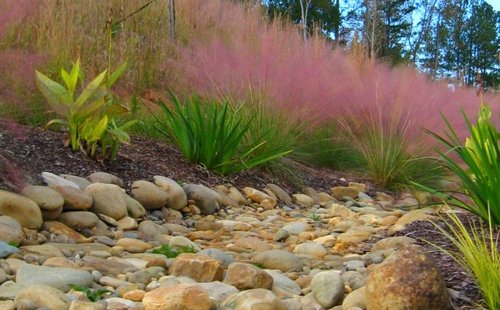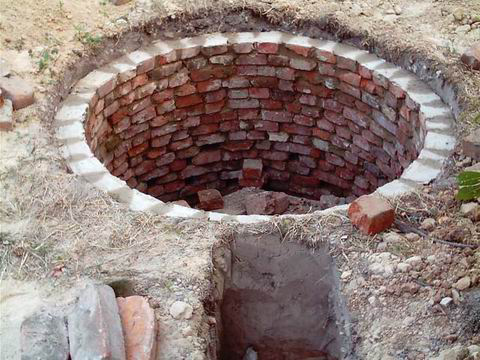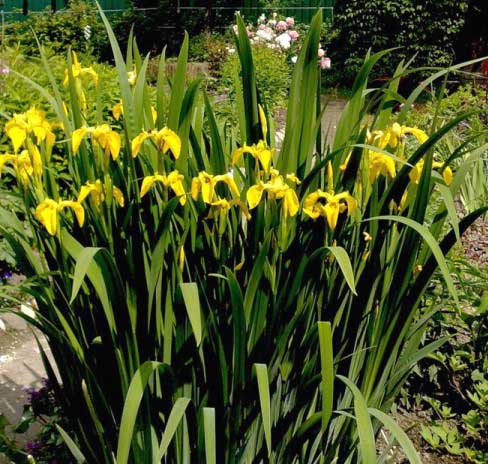Making houses adjoining portion sometimes causes some difficulty. In some cases they are linked to the territory of the terrain features and soil quality. Quite often required artificial draining soil with excessive moisture stagnation. In the event of such a problem, carefully Treat to selection of a suitable method to work performed gave effective results, but it does not reduce the attractiveness of the green zone.
Content
Which site requires artificial drainage?
Continuous excessive moisture retention in the soil can be caused by several factors:
- Location in the hollow portion.
- Incorrectly recorded in the process of building houses line the flow of groundwater, and their depth.
- Poorly planned use of various forms of landscape design.
- Incorrect layout of the house.
Important! Regardless of the reasons that triggered the increased soil moisture, with timely detection of problems, to restore a stable level in accordance with the type of land needs quite a force, even for self-fulfillment.
What problems will occur when an excess of moisture in the soil?
In case of ignoring the problem of excess moisture, the consequences will affect not only the quality of the soil, but also on the attractiveness of the entire site.
The most commonly arising results of high humidity are expressed in:
- Wash out the useful substances from the soil, and, as a result, quickly depletion.
- Whistling soil.
- Rotting soil and planted plants.
- The emergence of the nutrient medium for harmful bacteria and mushrooms.
- Reducing the attractiveness of the landscape.
- Air infection by pathogenic microbes.
- Unpleasant smell.
Important! The correctly chosen method of draining the soil, decorated in compliance with the rules of technology, will easily avoid a similar phenomenon.
What is the way to do choose?
There are several options for the full restoration of the normal humidity of the soil. Prefer one of the most popular solutions from the following:
- Ditch for water outflow.
- Drainage system.
- Drain with vegetation.
- Lifting the soil level.
- Construction of a pond.

Criterias of choice
To more clearly imagine the possibilities of correction of the situation and make the right decision, consider the following criteria when choosing a soil drain technology:
- The presence of inclination.
- Features of the relief of the territory.
- Depth of groundwater.
- Type of soil composition.
- Bookmark the foundation.
- Financial opportunities.
- Requirements for the attractiveness of the green zone at the place of the depth of moisture.

Important! Take a decision on the choice of the soil drain system, proceeding exclusively from the requirements of the requirements, and not several single coincidences.
Channel decoration for water removal
This principle of the device is characterized by special simplicity and low cost. Depending on the placement of such channels, they are separated into two types:
- closed;
- open.

Important! The first method was gaining great popularity due to the lack of violation of the attractiveness of the site and the convenience of using the system.
If this method is selected, familiarize yourself with some recommendations regarding the correctness of the formation of excessive outlet lines:
- Plan the location of the lines in such a way that the water surplus is essential to the river or well.
- If a plot with a rather noticeable bias, the direction will correspond to the lowering line of the soil.

- If the territory is common, then it is recommended to place the channels across the slope on its vertex. This approach will help reduce groundwater levels.
- When calculating the depth of the channel, focus on the standard 1-1.2 meters.
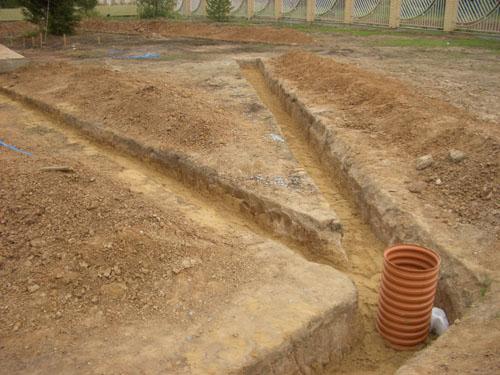
- The wall of the ditches for removing excess water. Take an angle of 20 degrees.
- Disposal channels in which all water from the drainage tracks will fall deeper so that all moisture directed from several lines remains on the surface with an insufficient place.
Important! Closed ditches are not visible, do not occupy an extra soil and do not interfere with free movement on the site. The only drawback is to samples that you have to look for a long time.

- Every year, perform planned wastewater treatment to prevent excessive channel clogging.
Important! Take into account when choosing this method, despite the fairly high practicality of such a decision, there are some difficulties in the process of exploitation of such a system. It is most often in difficult discovery of the place of clogging, which prevents the full and timely dying of the soil.

Types of drainage systems
In the case of the selection of the full-fledged drainage system, be sure to consider in advance that certain financial costs and time will be required to the proper formation of such a type of detention.
Browse the video to arrange the drainage surface system using a special finished equipment set.
Brick drainage
Please note this technology if the site does not differ in large sizes. The principle of the device of this system is quite simple, which is prevalent to review the basic rules for its design:
- Drop on a plot of 1 or 2 trenches.

- Direction Set the territory with an excess of moisture to the well.
- Trench sizes determine, based on the volume of regular surplus, but focus on the standard parameters of 0.5-1 meter of depth at 30 cm wide.
- Fill the bottom of the channel with a broken brick or granite chubby layer of 10-15 cm.

- Form the next layer of gravel.
- Lay over stone rocks an inverted turf along the entire length of the trench.
- Put the earth.
- Gently crumple the surface.
Important! An interesting solution will be such a way if you need to redirect the aqueous mass from one site to another.

Pottery drainage
This technology is also not particularly difficult, but additional consumables will be required. The principle of drainage consists in the discharge of excess water using a pipeline laid at a given depth.
Work on the design of pottery drainage as follows:
- Make a preliminary scheme of the water removal line.
- Carefully calculate the necessary pipe length for drying the soil.
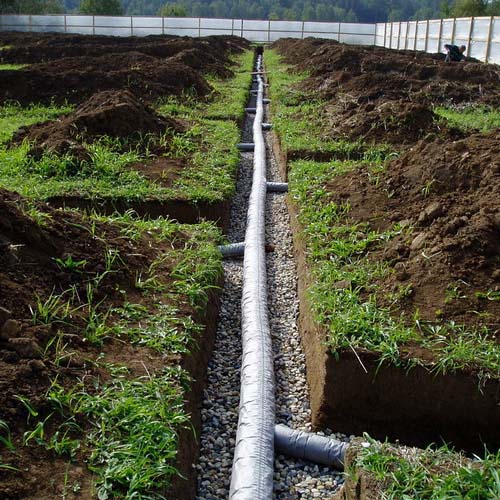
Important! When choosing this consumable material, give preference to plastic products. Such pipes like no other are excellent for use in an increased constant humidity. Their use will ensure the smooth operation of the system created for a long time in the absence of additional service efforts. Another option is plastic pipes, install when creating a winding system, since their flexibility will make it possible to issue any channel turns without breaking the material.
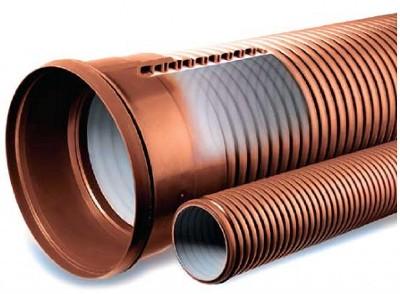
- Drop the trenches to install pipes at a depth of 1 meter.
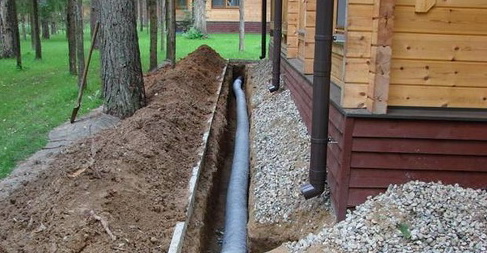
- Distance between lines determine depending on the type of soil:
- for clay soil, the appropriate gap is 4.5 meters;
- for a sandy type, it is enough to install pipes at a distance of 12 meters.
- To put pipes with a diameter of 10 cm in the central channels.

- The side trenches make products, the circumference of which is 5-7 cm.
- When connecting a central line with side drains, avoid sharp and straight corners to prevent the system to be quickly clogged.
- Form at the bottom layer of 5 cm from rubble.
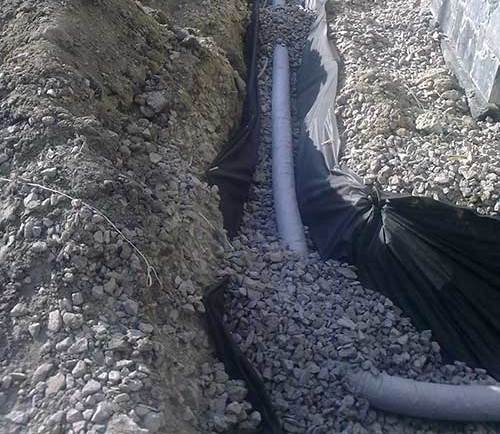
- Lay all pipes.
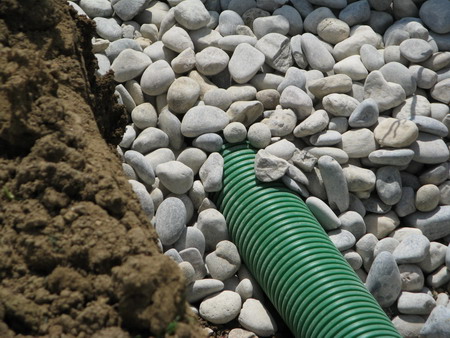
- All joints close the cloth.
- Secure them on top of a layer of boob stone.
- Pull the trenches with land pipes.
- Carefully scatter the surface.
Important! View video overview of drainage pipes to select the right products to arrange the drainage system.
Drainage well
This method choose in the absence of stationary drainage. Proper design is as follows:
- Drop the pit, the depth of which reaches 2 meters at a diameter of 1.5-2m.
- Strengthen the surface of the walls by masonry from a non-rigid brick solution.
Important! This approach will ensure proper outflow of water.

- The bottom of the well float the boob stone and broken brick.
- Run over the stone base of the geotextile web.
Important! If there is an excessive intensity of the flow of water, install a vibration pump for a constant liquid pumping.
View the video in which the formed system of this type of drainage is shown.
Soft drainage
The dimensions of such a system are not defined by specific rules. The main criterion in the formation of such a drainage is the intensity of the influx of excess moisture.
To improve this type of detention of the site, use the material of two types:
- nonwoven geotextile as a filter from various device contaminants;
- waterproofing material for molding lines of excess water outflows.
Important! The use of such technology for a long period will eliminate problems with retention of excessive moisture in the soil.

Principle of organization of the system:
- Dock the ditch.
- At the bottom of the waterproofing canvas.
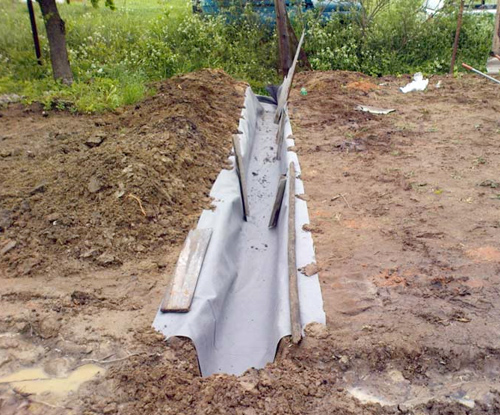
- To put geotextiles on top of it, the size of which is 30 cm exceeds the previous layer.
- Fall 2/3 trenches with rubble.

- Wrap a geotextile crushed stone layer.
- Fall off the sand.
Drain with plants
This option is most interesting about the arrangement of an attractive landscape without additional artificial systems. The natural drainage of the soil lies in the landing of those species of plants, for which the conditions of high humidity will be comfortable for development. At the same time, it is quite easy to combine them with other trees, shrubs and flower beds, since in this case a large part will still come to those rocks that require an increased dose of water.
Important! The effectiveness of this method is a little lower than when arranging special drainage systems, but it is best combined with the terms of the landscape design in some cases, especially when it is not possible to use another option possible by virtue of certain reasons.
Most often use the following trees for drying the soil:
Please note that trees planting technology to reduce the level of moisture in the ground differs from the usual procedure.
Review the applied recommendations for the execution of this work to prevent errors and ensure the proper result:
- Drop the pits under the selected breeds depth of at least 0.8 m.
- Pit sizes Make 1 * 1 m.
Important! Such enlarged parameters are necessary for the reason that the root system of trees for water removal is more developed and is distinguished by an impressive volume.
- At the bottom of the pit, form a layer of 50 cm from a major stone, mixing it with the ground.
Important! Do not use brick in this case. Prefer the possibility of natural durable breeds, resistant to destruction at a constant impact of moisture. This approach will not only provide a good support for the development of trees, but also will strengthen the drain effect. - Install the seedling in the pit, placing the root system well.
- Put the pit of the earth.

Raise the level of the Earth or create a pond?
To understand what exactly these two opposing options give preference, first familiarize yourself with the terms of each. Take into account the following recommendations:
- Raise the level of the soil only if the construction of the house has not yet begun. Otherwise, excessive moisture will constantly affect the basis of the structure, which will lead to a decrease in the life of the building. To perform this work, select a suitable company that supplies the soil. Be sure to check the quality of such land. After the purchase, fall asleep the plot of lowlands, thoroughly racing its surface.
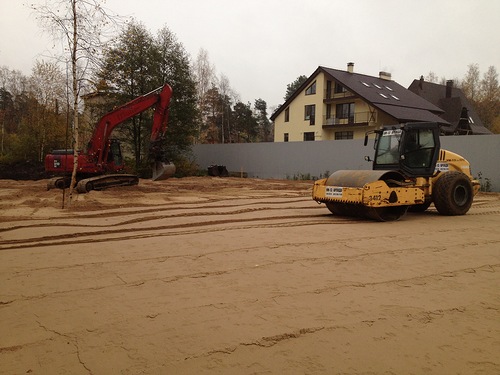
- Create a pond in a lowland, making it a removal of excessive water from the site with a drainage lines. This approach will be a rational solution in the case when the design of the landscape design assumes the presence of a water branch or territory is characterized by sufficient area.
Important! Please note that the design of the pond will bear not only the practical burden, but also to carry a clearly pronounced aesthetic character, significantly increasing the attractiveness of the whole area.

Conclusion
Regardless of how exactly the method of dedication of the soil you preferred, determine all the rules of arrangement. Only in this case, you will rate its effectiveness in a short time and prevent additional costs and time spent on reissuing the system due to an unsolved problem.






